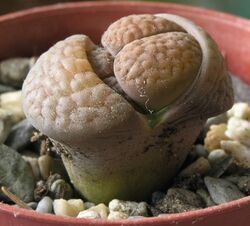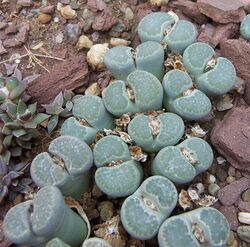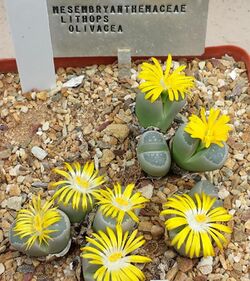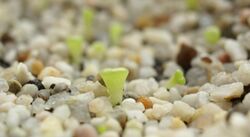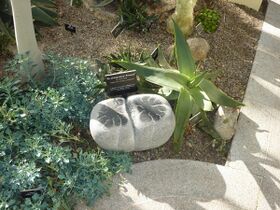Biology:Lithops
| Lithops | |
|---|---|
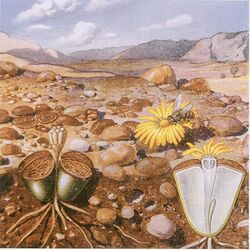
| |
| Lithops sp. by Marloth | |
| Scientific classification | |
| Kingdom: | Plantae |
| Clade: | Tracheophytes |
| Clade: | Angiosperms |
| Clade: | Eudicots |
| Order: | Caryophyllales |
| Family: | Aizoaceae |
| Subfamily: | Ruschioideae |
| Tribe: | Ruschieae |
| Genus: | Lithops N.E.Br.[1] |
| Species | |
|
See text | |
Lithops is a genus of succulent plants in the ice plant family, Aizoaceae. Members of the genus are native to southern Africa. The name is derived from the Ancient Greek words λίθος (Script error: The function "transl" does not exist.) 'stone' and ὄψ (Script error: The function "transl" does not exist.) 'face', referring to the stone-like appearance of the plants. They avoid being eaten by blending in with surrounding rocks and are often known as pebble plants or living stones. Lithops is both the genus name and the common name. The formation of the name from the Ancient Greek -ops means that even a single plant is called a Lithops.
Description
Individual Lithops plants consist of one or more pairs of bulbous, almost fused leaves opposite to each other and hardly any stem. The slit between the leaves contains the meristem and produces flowers and new leaves. The leaves of Lithops are mostly buried below the surface of the soil, with a partially or completely translucent top surface known as a leaf window which allows light to enter the interior of the leaves for photosynthesis.[2]
During winter a new leaf pair, or occasionally more than one, grows inside the existing fused leaf pair. In spring the old leaf pair parts to reveal the new leaves and the old leaves will then dry up. Lithops leaves may shrink and disappear below ground level during drought. Yellow or white flowers emerge from the fissure between the leaves after the new leaf pair has fully matured, one per leaf pair. This is usually in autumn, but can be before the summer solstice in L. pseudotruncatella and after the winter solstice in L. optica. The flowers are often sweetly scented.

The most startling adaptation of Lithops is the colouring of the leaves. The leaves are fenestrated, and the epidermal windows are patterned in various shades of cream, grey, and brown, with darker windowed areas, dots, and red lines, according to species and local conditions. The markings function as remarkable camouflage for the plant in its typical stone-like environment. As is typical of a window plant, the green tissue lines the inside of the leaves and is covered with translucent tissue beneath the epidermal windows.
Lithops are obligate outcrossers and require pollination from a separate plant. Like most mesembs, Lithops fruit is a dry capsule that opens when it becomes wet; some seeds may be ejected by falling raindrops, and the capsule re-closes when it dries out. Capsules may also sometimes detach and be distributed intact, or may disintegrate after several years.
Distribution
Lithops occur naturally across wide areas of Namibia and South Africa , as well as small bordering areas in Botswana and possibly Angola, from sea level to high mountains. Nearly a thousand individual populations are documented, each covering just a small area of dry grassland, veld, or bare rocky ground. Different Lithops species are preferentially found in particular environments, usually restricted to a particular type of rock. Lithops have not naturalised outside this region.
Rainfall in Lithops habitats ranges from approximately 700 mm/year to near zero. Rainfall patterns range from exclusively summer rain to exclusively winter rain, with a few species relying almost entirely on dew formation for moisture. Temperatures are usually hot in summer and cool to cold in winter, but one species is found right at the coast with very moderate temperatures year round.
Cultivation
Lithops are popular house plants and many specialist succulent growers maintain collections. Seeds and plants are widely available in shops and over the Internet. They are relatively easy to grow and care for if given sufficient sun and kept in well-draining soil.
Normal treatment in mild temperate climates is to keep them completely dry during winter, watering only when the old leaves have dried up and are replaced by a new leaf pair. Watering continues through autumn, when the plants flower, and then stops for winter. The best results are obtained in an environment with additional heat such as a greenhouse. In hotter climates, Lithops will have a summer dormancy when they should be kept mostly dry, and they may require some water in winter. In tropical climates, Lithops can be grown primarily in winter with a long summer dormancy. In all conditions, Lithops will be most active and need most water during autumn and most species will flower at approximately the same time.
Lithops thrive best in a coarse, well-drained substrate. Any soil that retains too much water will cause the plants to burst their skins as they over-expand. Plants grown in strong light will develop hard strongly coloured skins which are resistant to damage and rot, although persistent overwatering will still be fatal. Excessive heat will kill potted plants as they cannot cool themselves by transpiration and rely on staying buried in cool soil below the surface. Commercial growers mix a mild fungicide or weak strength horticultural sulfur into the plant's water to prevent rotting. Lithops are sensitive to watering during hot weather, which can cause the plants to rot; in habitat the plants are often dormant when the temperatures are high, doing most of their growing during the cool months of the year. Low light levels will make the plants highly susceptible to rotting and fungal infection.[3]
In the United Kingdom the following species have gained the Royal Horticultural Society's Award of Garden Merit:[4]
- Lithops karasmontana[5]
- Lithops olivacea[6]
- Lithops pseudotruncatella[7]
- Lithops salicola[8]
- Lithops schwantesii[9]
Cultivars
Mr Keith Green was appointed International Cultivar Registration Authority for Lithops in 2013, and recognises over 100 registered cultivars.[10]
Since Lithops are mostly propagated by seed, cultivars require to be stabilised as seed strains. Most cultivars are either abnormally green or abnormally red plants, lacking most of the normal leaf pigments. Some were initially found as isolated unusual plants in habitat, but increasingly have arisen from cultivation, sometimes by deliberately selecting mildly-coloured plants to achieve intense colours for a cultivar. The term "aberrant colour form" (acf.) has been used for these unusually-coloured Lithops.[11]
There are also so-called "pattern cultivars" of Lithops, seed strains which have been selectively-bred or stabilised from isolated unusual plants to have intensified or unusual leaf patterns, and sometimes unusual flowers. In some cases, these are hybrids.[10]
Propagation
Propagation of Lithops is by seed or cuttings. Cuttings can only be used to produce new plants after a plant has naturally divided to form multiple heads, so most propagation is by seed. Lithops can readily be pollinated by hand if two separate clones of a species flower at the same time, and seed will be ripe about 9 months later. Seed is easy to germinate, but the seedlings are small and vulnerable for the first year or two, and will not flower until at least two or three years old.
History
File:Lithops flower bud growth and first bloom - Time lapse HD video.ogv The first scientific description of Lithops was made by botanist and artist William John Burchell, explorer of South Africa , although he called it Mesembryanthemum turbiniforme. In 1811, Burchell discovered a specimen when picking up a "curiously shaped pebble" from the ground.[11] Unfortunately the documented physical description was not detailed enough to be sure which Lithops he had discovered and the name Lithops turbiniformis is no longer used, although for many years it was applied to what is now known as Lithops hookeri.
Several more Lithops were published as Mesembryanthemum species until in 1922 N E Brown started to split up the overly large genus on the basis of the capsules. The genus Lithops was created and dozens more species were published in the following decades. Brown, Gustav Schwantes, Kurt Dinter, Gert Nel, and Louisa Bolus continued to document Lithops from across southern Africa, but there was little consensus on the relationships between them, or even which populations should be grouped as species. As recently as the 1950s, the genus remained rather unknown in cultivation and was not well understood taxonomically.
In the 1950s, Desmond and Naureen Cole began to study Lithops. Together, the couple visited nearly all natural habitats of the different lithops populations and collected samples from approximately 400. They document and identify them, assigning a number, which is now known as the Cole number still used today all around the world. They studied and revised the genus, in 1988 publishing a definitive book (Lithops: Flowering Stones) describing the species, subspecies, and varieties which have been accepted ever since.
Because their camouflage is so effective, new species continue to be discovered. Recent discoveries include L. coleorum in 1994, L. hermetica in 2000, and L. amicorum in 2006.[12]
Taxonomy
Many of the species listed have named subspecies or varieties and some have many regional forms identified by old names or habitat locations. Identification of species is primarily by flower colour and leaf patterns. The species list here follows Cole & Cole (2006).[11]
| Specific epithet | Meaning |
|---|---|
| amicorum[14] | of the friends |
| aucampiae | named after Juanita Aucamp |
| bromfieldii | named after H. Bromfield |
| coleorum | named after Desmond & Naureen Cole |
| comptonii | named after Prof. Robert Harold Compton |
| dinteri | named after Moritz Kurt Dinter |
| divergens | divergent lobes |
| dorotheae | named after Dorothea Huyssteen |
| francisci | named after Frantz de Laet |
| fulviceps | tawny head |
| gesineae | named after Gesine de Boer |
| geyeri | named after Albertus Geyer |
| gracilidelineata | thin lined |
| hallii | named after Harry Hall |
| helmutii | named after Helmut Meyer |
| hermetica | named after the 'hermetically sealed' location, Sperrgebiet |
| herrei | named after Adolar 'Hans' Herre |
| hookeri | named after Sir Joseph Hooker |
| julii | named after Julius Derenberg |
| karasmontana | named after the Great Karas Mountains |
| lesliei | named after T. N. Leslie |
| localis | of a place |
| marmorata | marbled |
| meyeri | named after Rev. Gottlieb Meyer |
| naureeniae | named after Naureen Cole |
| olivacea | olive-green |
| optica | eye-like |
| otzeniana | named after M. Otzen |
| pseudotruncatella | had been confused with Conophytum truncatum |
| ruschiorum | named after Rusch family |
| salicola | salt-dweller |
| schwantesii | named after Gustav Schwantes |
| vallis-mariae | named after the location Mariental (Latinised) |
| verruculosa | warty |
| villetii | named after C. T. Villet |
| viridis | green |
| werneri | named after Werner Triebner |
Although the species, subspecies, and varieties published by Cole & Cole[11] largely remain accepted and in widespread use,[13] some variations have been published by other authors. Some published changes since 2006 include:
- reducing L. amicorum to a subspecies of L. karasmontana; combining L. karasmontana ssp. bella and ssp. eberlanzii into one subspecies; and combining L. herrei with L. optica.[15]
- raising L. dendritica and L. eberlanzii to species level and dropping all the separate varieties of L. karasmontana.[16]
- raising L. bella, L. burchellii, L. euniceae, and L. glaudinae to species level; combining L. dorotheae and L schwantesii var. marthae under L. dinteri; combining L. francisci, L. gesinae, and L. hermetica; combining L. geyeri under L. herrei; dropping separate subspecies of L. julii and L. gracilidelineata; splitting ssp. archerae, dendritica and groendrayensis from L. pseudotruncatella as L. dendritica; and dropping separate varieties under L. villetii.[17]
One study of non-coding chloroplast DNA (trnS-trnG intergenic spacer), nuclear ribosomal internal transcribed spacer (nrITS) sequences and AFLP data found that Lithops was not monophyletic since Dinteranthus, Schwantesia, and Lapidaria were involved. It identified 9 clades in which did not closely frame the accepted 37 species.[18]
Gallery
References
- ↑ "Genus: Lithops N. E. Br.". Germplasm Resources Information Network. United States Department of Agriculture. 2009-06-09. http://www.ars-grin.gov/cgi-bin/npgs/html/genus.pl?6900.
- ↑ Best of Both Worlds: Simultaneous High-Light and Shade-Tolerance Adaptations within Individual Leaves of the Living Stone Lithops aucampiae
- ↑ Ed Storms (1986). The New Growing the Mesembs. Storms. https://books.google.com/books?id=WC2vtgAACAAJ.
- ↑ "AGM Plants - Ornamental". Royal Horticultural Society. July 2017. p. 61. https://www.rhs.org.uk/plants/pdfs/agm-lists/agm-ornamentals.pdf.
- ↑ "RHS Plantfinder - Lithops karasmontana". https://www.rhs.org.uk/Plants/10366/i-Lithops-karasmontana-i/Details.
- ↑ "RHS Plantfinder - Lithops olivacea". https://www.rhs.org.uk/Plants/10370/i-Lithops-olivacea-i/Details.
- ↑ "RHS Plantfinder - Lithops pseudotruncatella". https://www.rhs.org.uk/Plants/10372/i-Lithops-pseudotruncatella-i/Details.
- ↑ "RHS Plantfinder - Lithops salicola". https://www.rhs.org.uk/Plants/150628/i-Lithops-salicola-i/Details.
- ↑ "RHS Plantfinder - Lithops schwantesii". https://www.rhs.org.uk/Plants/10373/i-Lithops-schwantesii-i/Details.
- ↑ 10.0 10.1 Keith Green. "The International Cultivar Registration Authority Register and Checklist for the genus Lithops N.E.Br.". https://scrapbooklithops.com/cultivars.html.
- ↑ 11.0 11.1 11.2 11.3 Cole, Desmond; Cole, Naureen (2005). Lithops—Flowering Stones. Cactus & Co. ISBN 88-900511-7-5.
- ↑ Eller, Benno M.; Ruess, Beatrice (1982). "Water relations of Lithops plants embedded into the soil and exposed to free air" (in en). Physiologia Plantarum 55 (3): 329–334. doi:10.1111/j.1399-3054.1982.tb00300.x. ISSN 0031-9317. https://onlinelibrary.wiley.com/doi/10.1111/j.1399-3054.1982.tb00300.x.
- ↑ 13.0 13.1 Hartmann, H.E.K., ed (2001). Illustrated Handbook of Succulent Plants: Aizoaceae F-Z. Springer. ISBN 3-540-41723-0.
- ↑ Cole, Desmond (2006). "Cactus&Co Journal". Cactus&Co X(1): 57–59.
- ↑ Arakaki, Mónica; Christin, Pascal-Antoine; Nyffeler, Reto; Lendel, Anita; Eggli, Urs; Ogburn, R. Matthew; Spriggs, Elizabeth; Moore, Michael J. et al. (2011). "Contemporaneous and recent radiations of the world's major succulent plant lineages". Proceedings of the National Academy of Sciences 108 (20): 8379–8384. doi:10.1073/pnas.1100628108. PMID 21536881. Bibcode: 2011PNAS..108.8379A.
- ↑ Earlé, Roy A.; Young, Andrew J. (2020). "The form, structure and size of Lithops N.E.Br. Seeds and the taxonomic implications". Bradleya 2020 (38): 195. doi:10.25223/brad.n38.2020.a20.
- ↑ H Jainta (2019). "Ein neuer taxonomischer Ansatz für die Gattung Lithops N.E.Br.". Avonia 37 (1).
- ↑ Kellner, A.; Ritz, C. M.; Schlittenhardt, P.; Hellwig, F. H. (2011). "Genetic differentiation in the genus Lithops L. (Ruschioideae, Aizoaceae) reveals a high level of convergent evolution and reflects geographic distribution". Plant Biology 13 (2): 368–380. doi:10.1111/j.1438-8677.2010.00354.x. PMID 21309984.
Literature
- Jainta, Harald (2017). Wild Lithops. Klaus Hess Verlag. ISBN 978-3-933117-93-9.
- Cole, Desmond T (1988). Lithops—Flowering Stones. Acorn Books. ISBN 0-620-09678-0.
- Cole, Desmond; Cole, Naureen (2005). Lithops—Flowering Stones. Cactus & Co. ISBN 88-900511-7-5.
- Hammer, Steven (1999). Lithops: Treasures of the Veld. BCCS. ISBN 0-902099-64-7.
- Schwantes, Gustav (1957). Flowering Stones and Mid-day Flowers. London: Ernst Benn.
External links
- Lithops info from the BBC (UK)
- A guide to the cultivation of Lithops
- Scrapbooklithops (General info & habitat photographs)
Wikidata ☰ Q133283 entry
 |
